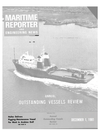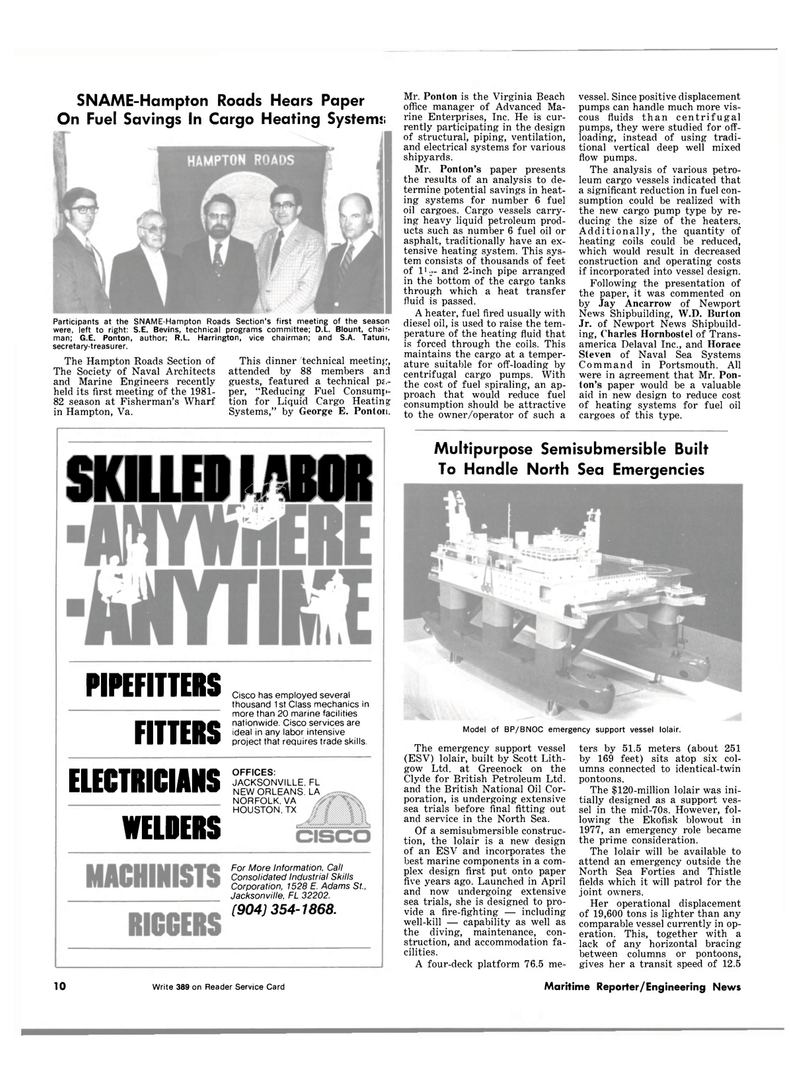
Page 6: of Maritime Reporter Magazine (December 1981)
Read this page in Pdf, Flash or Html5 edition of December 1981 Maritime Reporter Magazine
SNAME-Hampton Roads Hears Paper
On Fuel Savings In Cargo Heating Systems;
Participants at the SNAME-Hampton Roads Section's first meeting of the season were, left to right: S.E. Bevins, technical programs committee; D.L. Blount, chair- man; G.E. Ponton, author; R.L. Harrington, vice chairman; and S.A. Tatum, secretary-treasurer.
The Hampton Roads Section of
The Society of Naval Architects and Marine Engineers recently held its first meeting of the 1981- 82 season at Fisherman's Wharf in Hampton, Va.
This dinner/technical meeting, attended by 88 members and guests, featured a technical p£.- per, "Reducing Fuel Consump- tion for Liquid Cargo Heating
Systems," by George E. Ponton.
SKILLED LABOR
PIPEFITTERS
FITTERS
Cisco has employed several thousand 1 st Class mechanics in more than 20 marine facilities nationwide. Cisco services are ideal in any labor intensive project that requires trade skills.
ELECTRICIANS
WELDERS
OFFICES:
JACKSONVILLE, FL
NEW ORLEANS. LA
NORFOLK. VA
HOUSTON, TX
For More Information, Call
Consolidated Industrial Skills
Corporation, 1528 E. Adams St.,
Jacksonville, FL 32202. [904] 354-1868.
Mr. Ponton is the Virginia Beach office manager of Advanced Ma- rine Enterprises, Inc. He is cur- rently participating in the design of structural, piping, ventilation, and electrical systems for various shipyards.
Mr. Ponton's paper presents the results of an analysis to de- termine potential savings in heat- ing systems for number 6 fuel oil cargoes. Cargo vessels carry- ing heavy liquid petroleum prod- ucts such as number 6 fuel oil or asphalt, traditionally have an ex- tensive heating system. This sys- tem consists of thousands of feet of 11 •_>- and 2-inch pipe arranged in the bottom of the cargo tanks through which a heat transfer fluid is passed.
A heater, fuel fired usually with diesel oil, is used to raise the tem- perature of the heating fluid that is forced through the coils. This maintains the cargo at a temper- ature suitable for off-loading by centrifugal cargo pumps. With the cost of fuel spiraling, an ap- proach that would reduce fuel consumption should be attractive to the owner/operator of such a vessel. Since positive displacement pumps can handle much more vis- cous fluids than centrifugal pumps, they were studied for off- loading, instead of using tradi- tional vertical deep well mixed flow pumps.
The analysis of various petro- leum cargo vessels indicated that a significant reduction in fuel con- sumption could be realized with the new cargo pump type by re- ducing the size of the heaters.
Additionally, the quantity of heating coils could be reduced, which would result in decreased construction and operating costs if incorporated into vessel design.
Following the presentation of the paper, it was commented on by Jay Ancarrow of Newport
News Shipbuilding, W.D. Burton
Jr. of Newport News Shipbuild- ing, Charles Hornbostel of Trans- america Delaval Inc., and Horace
Steven of Naval Sea Systems
Command in Portsmouth. All were in agreement that Mr. Pon- ton's paper would be a valuable aid in new design to reduce cost of heating systems for fuel oil cargoes of this type.
Multipurpose Semisubmersible Built
To Handle North Sea Emergencies
Model of BP/BNOC emergency support vessel lolair.
The emergency support vessel (ESV) lolair, built by Scott Lith- gow Ltd. at Greenock on the
Clyde for British Petroleum Ltd. and the British National Oil Cor- poration, is undergoing extensive sea trials before final fitting out and service in the North Sea.
Of a semisubmersible construc- tion, the lolair is a new design of an ESV and incorporates the best marine components in a com- plex design first put onto paper five years ago. Launched in April and now undergoing extensive sea trials, she is designed to pro- vide a fire-fighting — including well-kill — capability as well as the diving, maintenance, con- struction, and accommodation fa- cilities.
A four-deck platform 76.5 me- ters by 51.5 meters (about 251 by 169 feet) sits atop six col- umns connected to identical-twin pontoons.
The $120-million lolair was ini- tially designed as a support ves- sel in the mid-70s. However, fol- lowing the Ekofisk blowout in 1977, an emergency role became the prime consideration.
The lolair will be available to attend an emergency outside the
North Sea Forties and Thistle fields which it will patrol for the joint owners.
Her operational displacement of 19,600 tons is lighter than any comparable vessel currently in op- eration. This, together with a lack of any horizontal bracing between columns or pontoons, gives her a transit speed of 12.5 10 Write 389 on Reader Service Card Maritime Reporter/Engineering News

 5
5

 7
7
